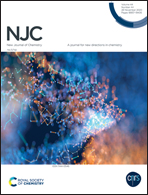Boronic acids for functionalisation of commercial multi-layer graphitic material as an alternative to diazonium salts†
Abstract
A novel radical-based functionalisation strategy for the synthesis of functionalised commercially obtained plasma-synthesised multi-layer graphitic material (MLG) is presented herein. 4-(trifluoromethyl)phenyl boronic acid was utilised as a source of 4-(trifluoromethyl)phenyl radicals to covalently graft upon the graphitic surface of MLG. Such a methodology provides a convenient and safer route towards aryl radical generation, serving as a potential alternative to hazardous diazonium salt precusors. The structure and morphology of the functionalised MLG (Arf-MLG) has been characterised using XPS, Raman, TGA, XRD, SEM, TEM and BET techniques. The XPS quantitative data and Raman spectra provide evidence of successful covalent attachment of 4-(trifluoromethyl)phenyl groups to MLG.



 Please wait while we load your content...
Please wait while we load your content...